Complete Guide on How to Make Business Cards
Author :
- What are Business Cards?
- How Important are Business Cards?
- Key Information That Your Business Card Must Include
- How to Make Business Cards in 7 Steps
- Best Practices for Customizing and Designing a Business Card
- Some Helpful Tips for Printing
- Why Choose Artisticore to Make Professional Business Cards?
Business cards are the golden ticket to a company’s success. They introduce you and get business deals moving. Business cards help people remember your name and job title when they need to get in touch with you later.
Giving out a business card casually at some fancy event is still professional and means business. In a world where everything is going digital, business cards remain a true part of how we carry out business, and they lead by example.
It’s also a quick and easy way to share your info without needing your phone. But what is a business card, and above all, why does it matter?
To find that out, we will discuss all about business cards in this blog, including what to put on them and how to design and print them.
More so, we’ll learn how to make business cards using something as simple as Microsoft Word. So, without any further ado, let’s dive in.
What are Business Cards?
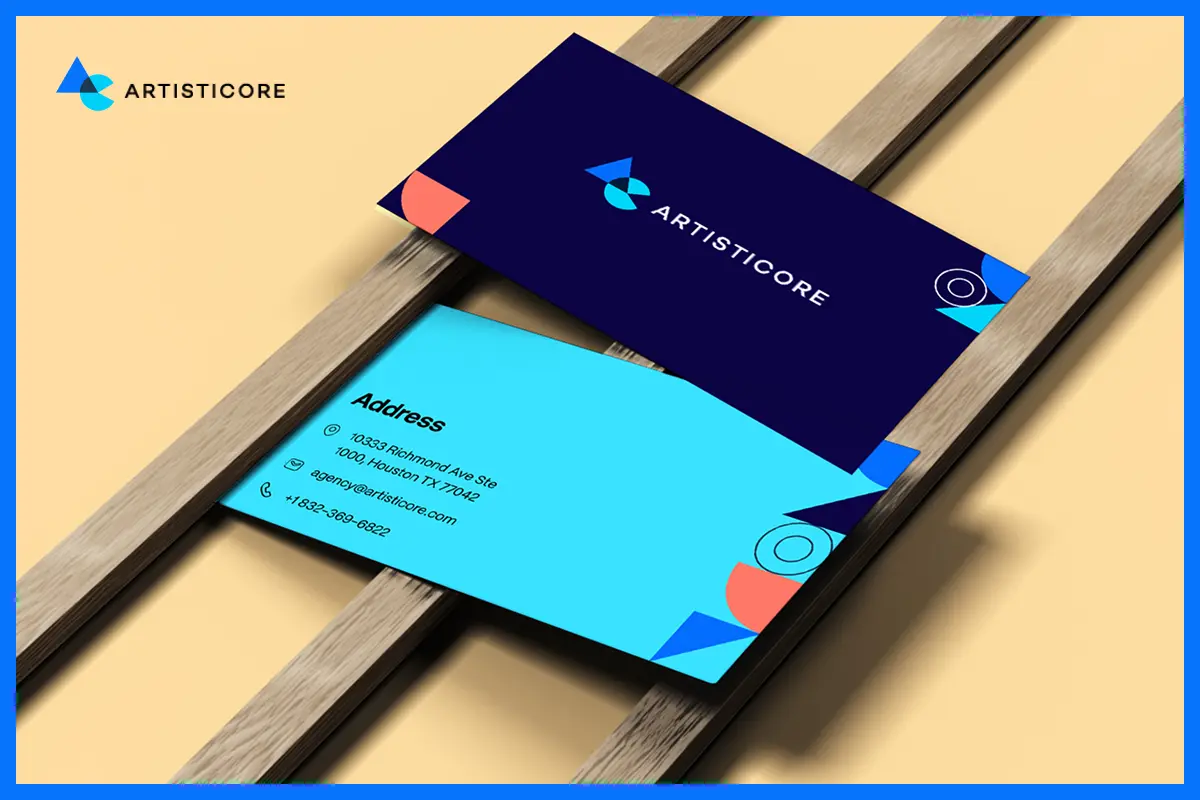
Business cards are small cards that provide your important information to someone else: your name, job, and contact information.
Business cards are usually credit-card size and fit snugly in a wallet or inside a pocket. You can use them in business meetings or during conversations with someone you have just met.
Your business card links you with someone you’re meeting across a crowded room or at a chance encounter. Business card designs vary, but they all serve a similar, albeit crucial, purpose.
The purpose is to help people recall your name and get in touch later on. Business cards serve as a small intro in someone’s hand.
Want Stunning Business Cards? Let Artisticore Create Custom Card Designs.
How Important are Business Cards?
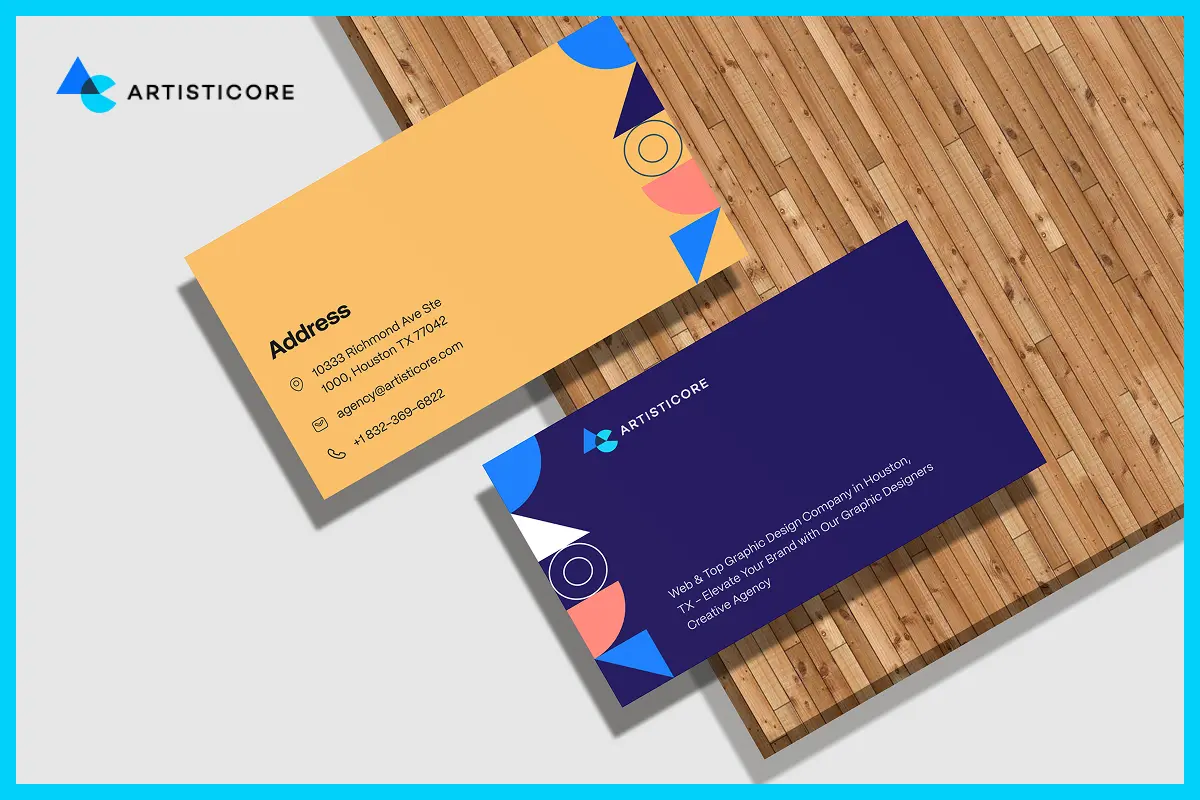
Business cards matter greatly today in a world where all things have gone digital. Giving someone your card upon meeting them face to face always beats asking people to follow you online.
Possessing an impressive business card shows professionalism and gives an air of thought and consideration. People can remember you later on because of it. In fact, your business card often serves as the first impression of your overall brand identity — which plays a powerful role in how your audience perceives your business.
If you are attending functions or meetings, your card will help separate you from everyone else. Also, not everyone can pull out their phone fully ready to write down their information.
So, a business card is convenient for that! Simple as that, a business card is a simple tool, but it can create big opportunities!
Key Information That Your Business Card Must Include
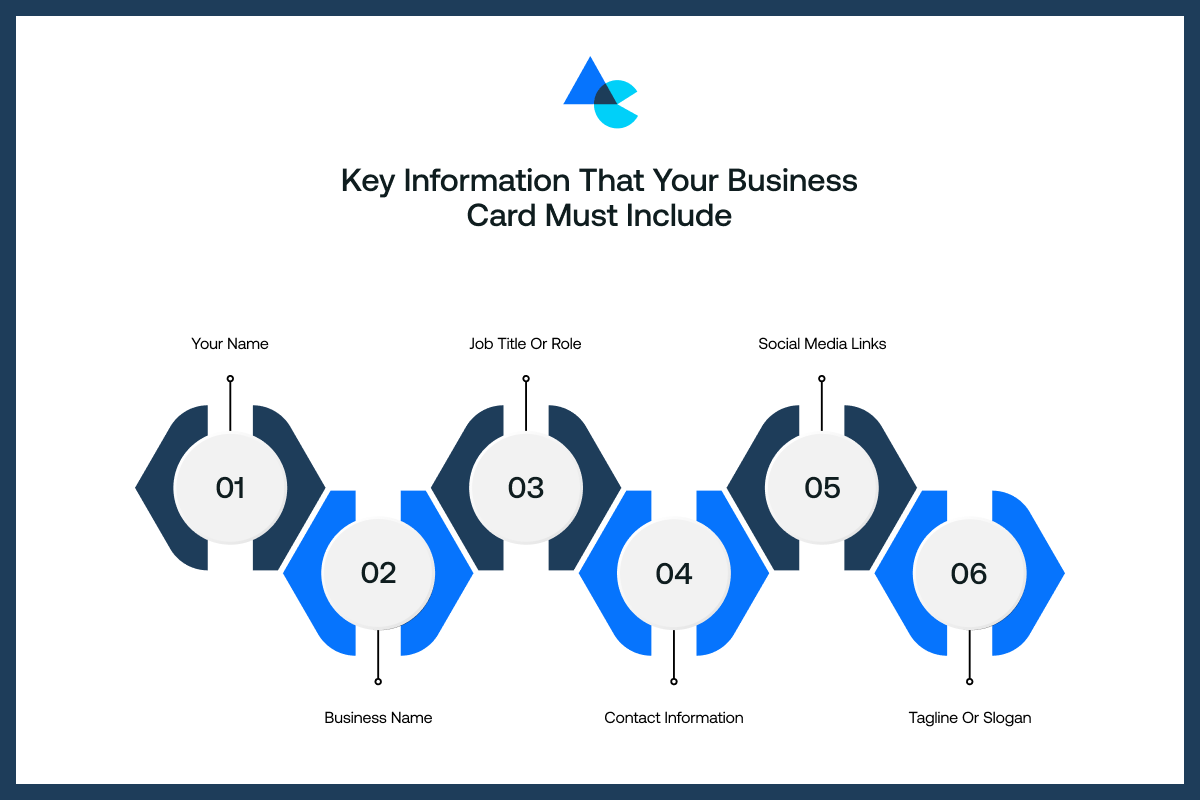
When you get to designing a business card, you must add info that matters. The info will let people know who you are, what you do, and how to contact you. This information bits are as follows:
- Your Name: This is the most basic but most important part. Your full name makes recalling you easy for others. Make sure text visibility is clear, and reading it doesn’t require squinting on somebody’s part. You might even want to include a professional nickname you go by.
- Job Title or Role: Your business card must let others know what you do. For that, you will need to add your job title, as it lets people know your line of work and what kind of services or help they might get from you.
- Business Name: Include a business name if you own one or work for some business entity. Your personal brand resonates with the business you represent.
- Contact Information: Add your contact number and email address so people can get in touch with you. Avoid using outdated info, as no one wants to dial wrong numbers or receive bounced emails.
- Social Media Links: Add social media profiles like Instagram and Facebook if you use them as your workspace. They can help showcase your skills and give service updates.
- Tagline or Slogan (optional): A fun, catchy phrase or short sentence helps people recall what you do with some creative wording. It adds a dash of flair to your card and helps folks recall your brand.
How to Make Business Cards in 7 Steps
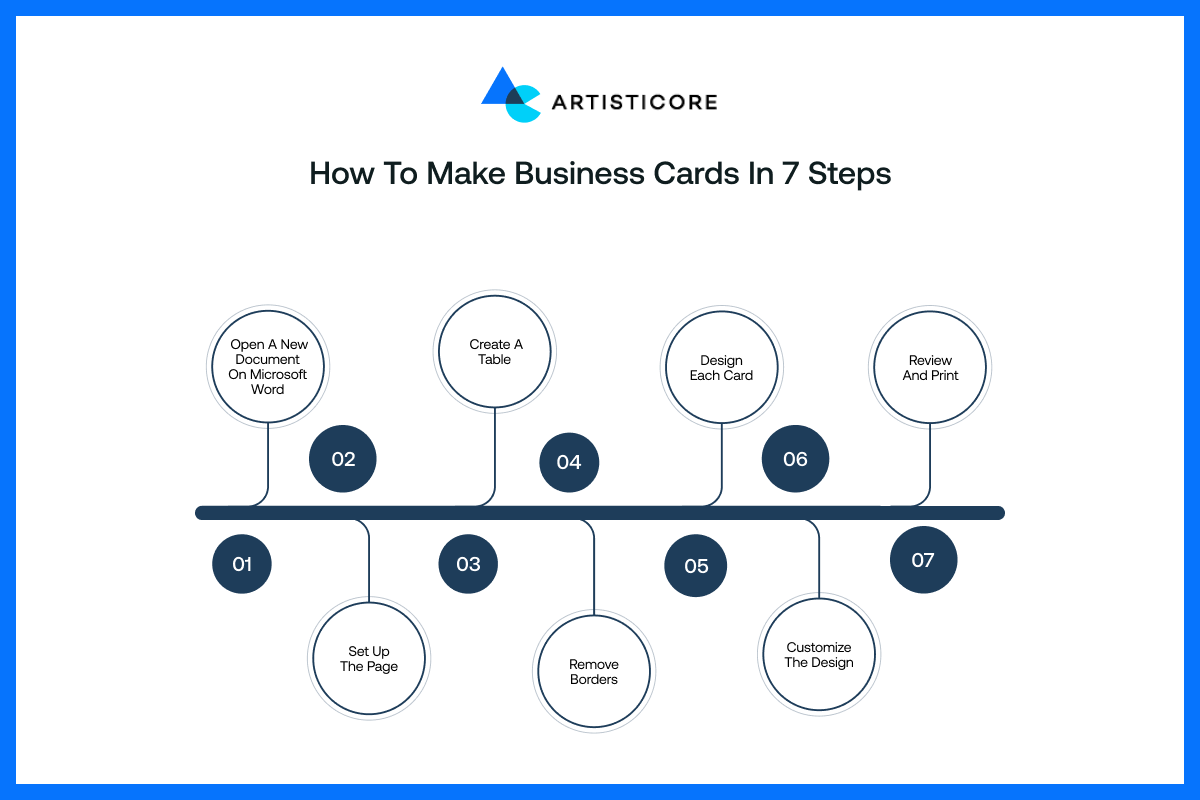
Are you wondering how to make business cards from the very beginning? You can make and design business cards all on your own, all by using Microsoft Word. It is an easy way to create business cards. Therefore, these seven steps are as follows:
Step 1: Open a New Document in Microsoft Word
Kick things off by opening Microsoft Word. In it, click on “new document” to get a blank document. Starting fresh gives you the space to create a design for your cards without having an existing layout to override.
When your page has opened, you have an empty space that is completely your own to make any size, any colors, and ultimately whatever you choose to be. Now, you are ready to create a blank page that will turn into a page of great business cards.
Step 2: Set up the page
Next, you will make the adjustments to the page. Find your layout settings and change the page to Landscape mode to turn the page sideways. After the page has changed to this orientation, you will find the page margins.
Select the narrowest option to adjust the page margins. This will allow you to fit several cards across the sheet. These quick adjustments will ensure everything fits just right when printing time approaches.
Step 3: Create a table
You must keep your cards all organized. And the best approach to do so is to add a table to the page. You can insert a table with 2 columns and 5 rows. That way, you will have ten equal spaces for cards at the end of the week.
So, right-click on the table, and you can tweak the cell size to standard business card size. The business card size is: 3.5 inches in width and 2 inches in height.
A table makes all the difference. It makes the design process easier because everything lines up perfectly and gets cut with precision.
Step 4: Remove borders
Lines usually surround each box when inserting a table, and you don’t want to have them on the final printed cards. Right-click anywhere in the table and tweak border settings off to get rid of those lines from view.
This will not disrupt any layout you have. It just cleans things up and gives your card a more polished look without the added lines that do not belong in your final version.
Tired of Dull Business Cards? We Create Card Designs that Make You Stand Out.
Step 5: Design each card
Next, it’s time to add your details. You can do so by clicking on each box and typing your details. These include your name, job title, telephone number, and email.
Make your name bold and bump up font size so it stands out and is noticeable. Opt for the insert image option whenever including your logo in the card. Every card will have the same details, so they can be handed out at any time.
Step 6: Customize the design
This is the fun part! Add fun bits to your card, such as icons, shapes, or borders. All of these will help make your card stand out.
Use your creativity to change up font styles, add background colors, and highlight certain text or sections of your card.
Remember to keep everything readable. So while you have fun experimenting with the card, don’t get carried away. Also, don’t go overboard with the designs and lose readability.
Adding a touch of style and personality can do wonders for your card. More so, your card design should match your vibe and brand.
Step 7: Review and print
Before you print, check everything one more time. Verify against spelling mistakes, alignment issues, or anything that looks funny. If you cannot tell, then don’t worry about it; these are just your practice business cards!
Print a test page first on regular paper. If everything looks good, you’re ready to print cards on cardstock or thicker paper.
For super clean cuts, you can use a paper cutter or pre-scored business card sheets. Once done, you’re good to go and can now start handing out your business cards.
Best Practices for Customizing and Designing a Business Card
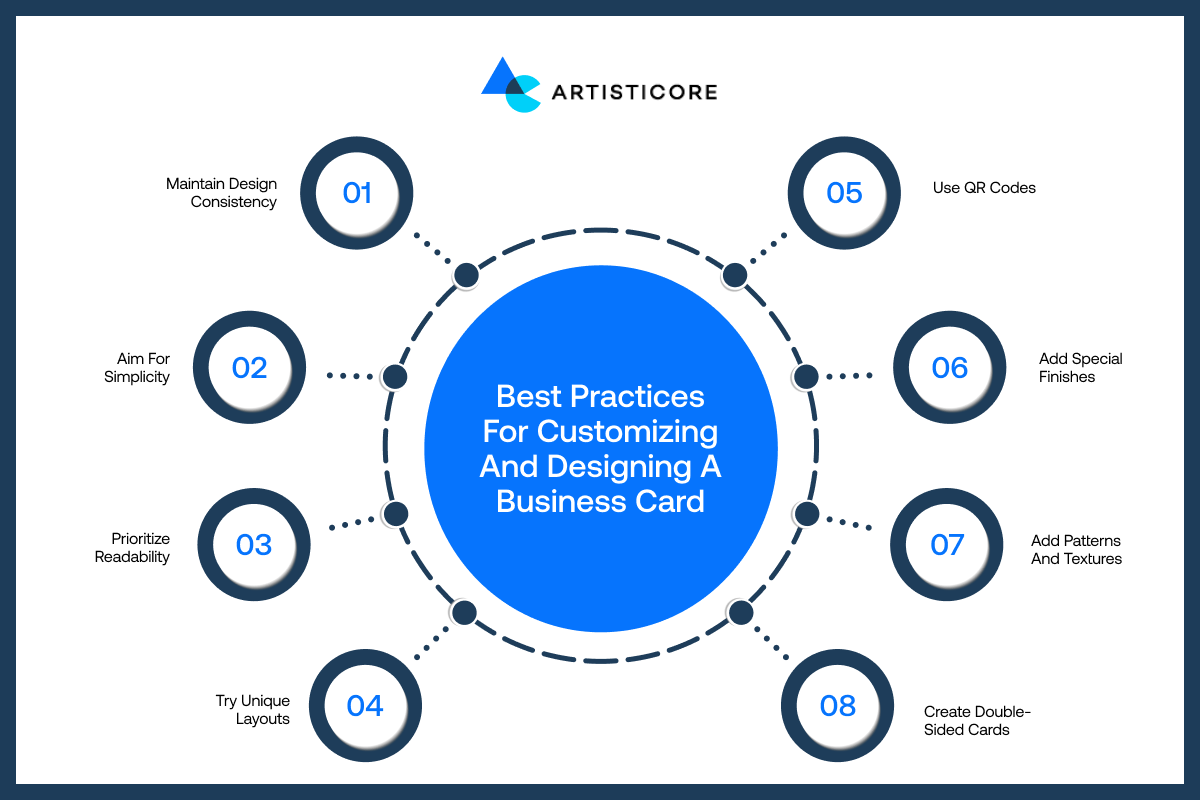
Want to know how to make business cards that tick? These design tips will help you create a card that rules:
Maintain Design Consistency
Keep your cards’ design on par with your brand image. You can do so by matching its colors, fonts, and design with the ones on your site, social media, and logo.
It will help people remember your brand and recognize it immediately. Plus, consistency looks professional and thorough!
Aim for Simplicity
Simplicity reigns supreme in design. Keep your card clear of clutter by featuring minimal images that don’t take over. A clear layout enables folks to easily focus on important details like your name or contact info.
Include a few essential elements and ensure the design isn’t too cluttered by using white space so that information can easily be seen on the card.
Prioritize Readability
Fancy fonts can appear good, but often fall short on readability. Go for legible typography so folks can read your info without straining their eyes.
Ensure text color has sufficient contrast against the background. You can do so by using dark colors on light surfaces or vice versa. Maintain a neat layout and format text concisely so that it is visible at first.
Try Unique Layouts
While most business cards are rectangular in shape, you don’t have to follow their strict mold! Consider doing a vertical layout, rounded corners, or even square cards.
Unique shapes and creative business card designs will help your card stand out from the mess of cards. Being unique isn’t everything, though; you have to be practical, too, and help ensure your card fits nicely into someone’s wallet or cardholder.
Use QR Codes
Adding a QR code to a card is a smart way of connecting with people. You can use the QR code as a link to your website, portfolio, social media page, or contact page.
This is great because it saves space on your card. More so, it gives people access to the additional info they need about you. QR codes need to be clear for easy scanning.
Add Special Finishes
If you are getting them done professionally, you may want to add cool touches like shiny foil, embossed text, and spot gloss.
These details increase how premium and memorable your card will feel. Special finishes will increase the fanciness of the look, while also being fun to touch and hold, making your card more memorable.
Add Patterns and Textures
Plain and solid cards work well, but light patterns or textures can add extra life to your design. Consider adding a soft background pattern, a gradient, or even a fabric-style texture.
These little considerations bring an extra dimension to your design without being overwhelming. Just make sure your text is still clearly readable!
Create Double-Sided Cards
Why confine yourself to just one side? Why not include the back of your card as well, to maximize value, by using it to include a slogan, logo, or even a mini portfolio?
You’ll give yourself more space and add more interest to your card. Just be sure that the communication is consistent in style from one side to the other, and that it doesn’t feel too ‘crowded’.
Need Help Making Your Business Card Idea? Work with Our Experts to Design Clean Cards.
Some Helpful Tips for Printing
Now that you have learned how to make your own business cards, you must print them right before distributing them. That way, you can save a lot of time (and paper). So, follow these tips for that:
- Use a Quality Printer: Having a decent printer makes a significant difference to the quality of your business card printing. Low-quality printers will either mess up your text or give the wrong color shades. A quality printer with a high resolution will not do that. Instead, it will make your print look clean, crisp, and on point. If you are learning how to make business cards at home, then make sure to check your ink levels when printing them. Also, use the right printer settings.
- Test the Print: Print a test page first before embarking on a lengthy printing job. This helps ensure orientation stays correct and colors appear accurate while the whole image remains centered on the page.. Additionally, it is much better to catch a mistake early than to fix it later and waste your paper and time in the process. One simple test print could save you a lot of hassle!
- Go for Professional Printing: If you desire to see your cards look great, you may want to consider a professional printing company. Print companies have heavier stock, better cuts, and options such as glossy or rounded corners. Professional printing makes the cards look more professional and higher-end, both of which can make a more positive impression on others.
Why Choose Artisticore to Make Professional Business Cards?
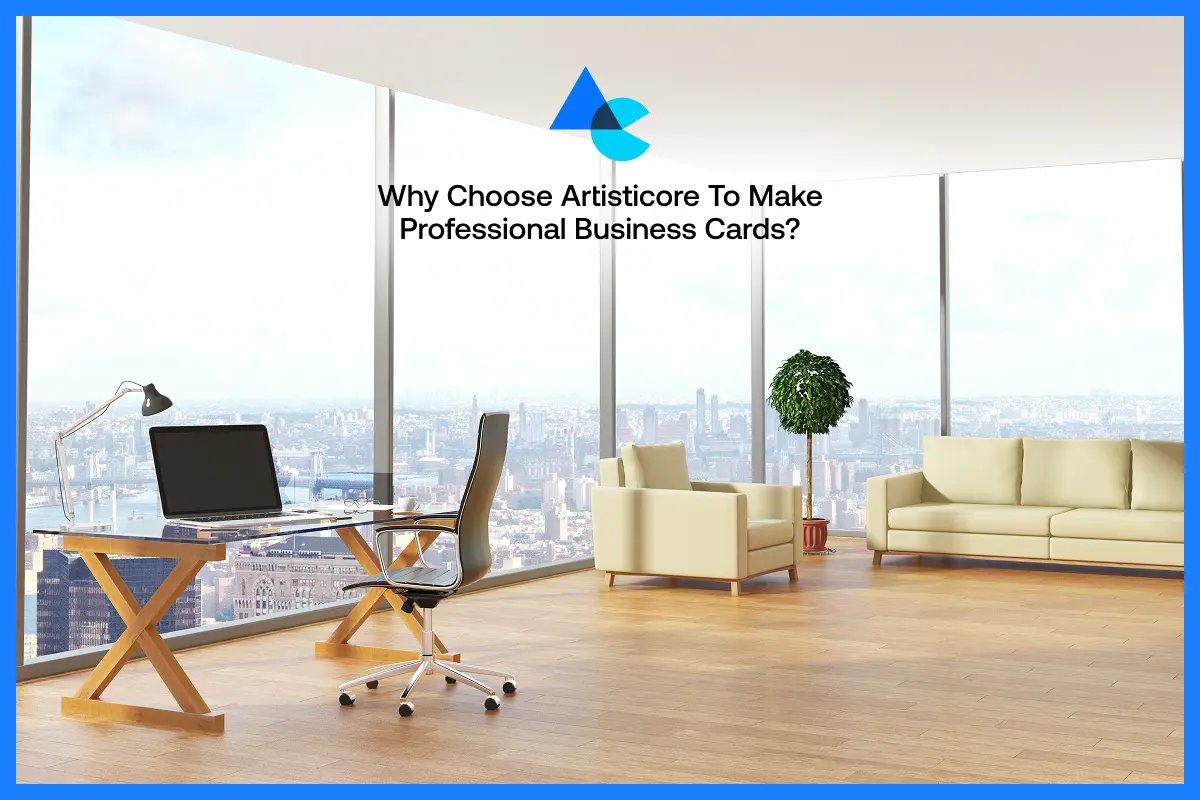
Creating business cards might seem easy, but making one that stands out requires talent and a dash of creativity with experience. That is where Artisticore can help!
We know how to make business cards because we understand key elements like layouts and consistent branding that go into card-making. The Artisticore team creates business cards that stick in customers’ minds.
We go for sleek, minimal designs and bright colors to showcase your brand in a bold and professional way. More so, we can help with everything from layout to final print-ready files. We take care of everything so you don’t have to.
If you are looking for business cards that look professional and feel premium, and would like a creative partner that you can rely on, see our previous business card work. Artisticore is that company.
Final Thoughts
That is all for this blog on how to make business cards. While they may only be small bits of cardstock, business cards have a significantly large impact in terms of how people recall you. For instance, a well-designed card demonstrates you are serious, creative, and professional in an instant. Whatever way you design your card, you must remember the basics. These are to keep the card clear, stylish, readable, and on par with your business branding.
Properly designed business cards possess the power to open doors of business opportunities, create links, and leave impressions. So, take your time with your business card and go through the proper steps. While you are at it, don’t be afraid to explore your creative side. And if you don’t know how to make business cards and need help making one, you can consider Artisticore for the job. A great business card is more than just paper: it’s an effective part of your identity.
